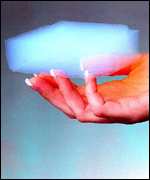n. An extremely lightweight, porous substance made from a silica gel in which the liquid has been replaced by air; an aerogel.
2002
Like glass, it is made from silicon dioxide and sand. Unlike glass, it is 99.8% air. The stuff is formally known as aerogel, and unofficially as "frozen smoke". A packet of the glassy, spongy stuff is already aboard a spacecraft called Stardust, designed to catch fragments of a comet called Wild-2 in 2004. Steven Jones of the Jet Propulsion Laboratory in Pasadena has composed an aerogel that weighs three milligrams a cubic centimetre. It has been recognised by Guinness World Records as the world's lightest solid. "It is probably not possible to make aerogel any lighter than this because then it wouldn't gel," said Jones.
1990 (earliest)
Scientists at Lawrence Livermore National Laboratory in California have developed a fluffy substance that contains so little solid matter it is almost invisible, but that can nevertheless support fairly heavy weights.
The new material, consisting of linked microscopic fibers of silica, has been dubbed ''frozen smoke'' because of its extreme lightness and transparency. The lightest version of the material developed by the laboratory has a density of only 5 milligrams per cubic centimeter, about the density that would result if a teaspoon of water could be dispersed uniformly throughout a volume of more than one gallon.
The new material, consisting of linked microscopic fibers of silica, has been dubbed ''frozen smoke'' because of its extreme lightness and transparency. The lightest version of the material developed by the laboratory has a density of only 5 milligrams per cubic centimeter, about the density that would result if a teaspoon of water could be dispersed uniformly throughout a volume of more than one gallon.

In pictures an aerogel is nearly transparent, has a light-bluish tint, and is blurred at the edges, so researchers have given it the nickname frozen smoke (others are solid smoke, blue smoke, and San Francisco fog).
